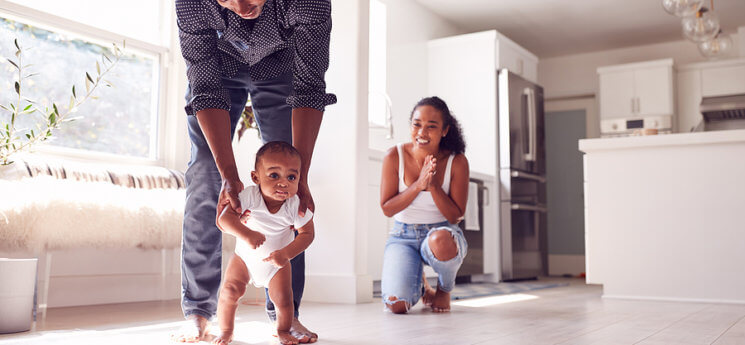It probably seems like your baby has sat up, crawled, and started cruising all in the blink of an eye—and now, you’re probably anxious about him meeting the biggest milestone of all: Learning how to walk.
Walking is major turning point because it helps babies become more independent and explore their world in a new way, plus develop different muscle groups. Your baby will likely start walking sometime between 8 and 18 months, depending on his genetics, level of determination, as well as physical strength, says Martha Rivera M.D., a Los Angeles pediatrician fellow of the American Academy of Pediatrics. Still, every baby is different, and yours will start trying to teeter on two feet when he’s ready.
How to help baby walk
There are a few clues that your child might be ready to walk. Cruising, or using furniture to get around, is one sign; trying to take a step before plopping down is another. What’s more, there are plenty of things you can do to offer encouragement and help baby walk.
Use a push toy
A push toy like a vacuum or lawnmower is one tool that can help baby walk. Unlike a walker, a push toy won’t keep your baby contained, helping her build arm and leg strength while maintaining a wider stance for balance. Push toys also encourage problem-solving skills that help baby walk, like turning around or backing up.
While your baby is toddling around with her push toy, act as her focal point at the other end of the room while using words of encouragement like, “Come on, you can do it, come this way to Mommy!” After she reaches you, celebrate her accomplishment by cheering, clapping your hands, and giving her a big hug. Positive reinforcement and praise, Rivera says, offers encouragement that will help baby walk.
Safe-proof the cruising area
While your baby learns to walk, he’ll likely be pretty wobbly. Creating a safe cruising area will protect him from potential falls, helping him feel safer—and more willing to try taking another step. If you haven’t already, secure heavy furniture (like the TV), cover any exposed outlets or sharp table corners, and install baby gates wherever cruising off-limits (like near the stairs). When he does take a tumble, try to stay calm, which will make him feel OK about getting up and trying again, says Rivera.
Know what can hold her back
Some things can actually hinder your baby’s attempts to walk. If you help baby walk without socks and shoes, she’ll have better balance and will develop stronger muscles in her feet, ankles, legs, and hips. Walkers should also be off-limits: Besides being dangerous, they encourage babies to walk on their toes and hyperextend their lower legs, Rivera says.
Finally, try not to hold your baby or hover too much when she’s cruising. Babies learn by trial and error, so give her some room to make mistakes—and grow from them—on her own.




